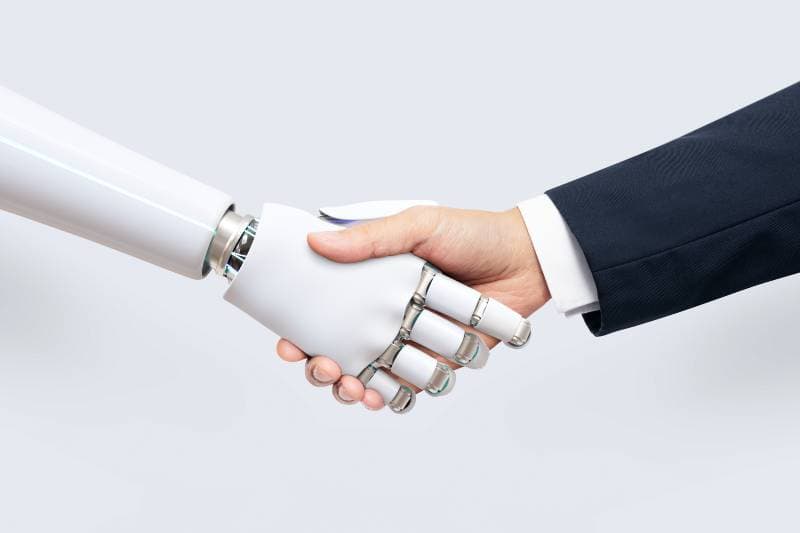Are you wondering what the future of content marketing holds? Technology continues to evolve at a staggering rate and Artificial Intelligence (AI) is playing an increasingly important role in shaping how we interact with ideas and strategies. Predictive analytics based on AI are revolutionizing the way businesses are utilizing data to propel their content marketing efforts. With the help of evolved technology, marketers can anticipate emerging trends before they even become widely popular.
In this blog post, we’ll explore why AI-based predictive insights offer such valuable information for content marketers, as well as some tips for leveraging this technology effectively. Get ready to discover what predictions lie ahead in your next successful content marketing campaigns!
Incorporating AI into marketing activities has been embraced by 61.4% of marketers. Furthermore, 44.4% of marketers have utilized AI specifically for AI content creation.
Key Takeaways
- AI enhances trend prediction by rapidly analyzing vast amounts of data, offering more precise insights compared to traditional methods.
- While AI is a powerful tool, human creativity in content marketing remains essential. Marketers must strike a balance.
- AI will continue to play an integral role in content marketing, evolving with new technologies and changing the way marketers plan and execute their strategies.

Historical Context
In the past, identifying trends in content marketing relied on a combination of intuition, observation, and experience. Marketing pioneers would often determine what was “trending” based on gut feelings or personal insights. They’d carefully observe which print advertisements got the most attention, which television commercials led to a spike in phone calls, or which radio spots generated buzz in the community.
For example, in the 1960s, if a car advertisement emphasized luxury and this led to increased sales or inquiries, other brands would soon adopt a similar approach. They looked to popular culture, such as movies and music, to gauge what resonated with the public, and molded their campaigns accordingly. The famous ‘Got Milk?’ campaign from the 1990s is an example of a trend sparked by a simple, yet powerful, insight into consumer behavior.
With the dawn of the internet and the digital age, marketers began to harness the power of online analytics tools. Websites, emails, and digital ads offered an unprecedented level of trackability. Marketers could now see how many clicks an ad received, which emails were opened, or which pages on a website were most frequently visited. With the proliferation of social media platforms like Facebook, Twitter, and Instagram, marketers got a direct pulse on what consumers were talking about, liking, and sharing.
Now, instead of solely relying on instinct or anecdotes, they could base decisions on concrete numbers. For instance, if a blog post about “10 Ways to Recycle Household Items” received a surge in shares and comments, it indicated a growing interest in sustainability, prompting more content in that direction.
The Shift Towards Data-Driven Insights and AI in Trend Analysis
As we entered the era of big data, the volume of information available to marketers became both a blessing and a curse. On one hand, there was a treasure trove of insights waiting to be discovered; on the other, it was like finding a needle in a haystack. Enter Artificial Intelligence (AI) and machine learning.
With AI, the process of identifying content marketing trends underwent a transformative shift. Instead of manually sifting through mounds of data, marketers could use algorithms to spot patterns, predict future behaviors, and identify emerging trends with a degree of accuracy previously thought impossible.
Here’s an easy-to-understand example: Imagine you’re a marketer for a fashion brand. In the past, you might have scoured fashion magazines, attended trade shows, and conducted surveys to get a sense of the next big trend. Today, with AI, you could analyze thousands of social media posts, online articles, and e-commerce data points to detect that, say, neon colors are gaining traction. Within hours, you might identify that neon green in particular is being discussed 20% more than last month, and you’d pivot your marketing accordingly.
Furthermore, AI tools can also be used for sentiment analysis. This means they don’t just track what’s trending, but also how people feel about those trends. For instance, if the data reveals a growing interest in vegan leather jackets, AI can further decipher whether the sentiment around this trend is positive, neutral, or negative.
How AI Predicts Trends
The fascinating world of Artificial Intelligence (AI) isn’t just about robots and self-driving cars; it’s also reshaping how we understand human behavior and predict trends, especially in the domain of content marketing. The very core of AI’s power lies in its ability to process vast volumes of data quickly and intelligently. To really grasp this, let’s delve into the key methods AI employs to perform this magic trick.
1. Natural Language Processing (NLP):
NLP is all about enabling machines to understand, interpret, and generate human language. Imagine being at a café and overhearing countless conversations around you. To a human, deciphering all these chats would be a colossal headache, but for AI, it’s a piece of cake! By leveraging NLP, AI can read countless blog posts, tweets, reviews, and comments, extracting meaningful insights from them. It comprehends the semantics, context, and sentiment of the ai generated content, helping marketers identify what’s being said about their brand or a particular topic and how people truly feel about it.
Easy Example: Suppose there’s a surge in articles and tweets about ‘sustainable travel.’ NLP can tell if the sentiment is overwhelmingly positive (e.g., excitement about eco-resorts) or mixed with concerns (e.g., debates about carbon footprints).
2. Machine Learning:
Machine learning, a subset of AI, is akin to training a pet, but in this case, the pet is a computer. By feeding it tons of data and teaching it to recognize patterns, over time, it starts making predictions on its own. In the context of content marketing, machine learning can be used to anticipate which types of content will likely resonate with a particular audience based on past behaviors and preferences.
Engaging Illustration: Think of Netflix’s recommendation engine. It observes what you’ve watched, and based on patterns and user similarities, suggests shows you might enjoy next. Similarly, if a marketer observes that users who enjoy reading about ‘DIY home decor’ also gravitate towards ‘upcycling furniture tutorials,’ they might produce more of the latter content.
3. Predictive Analysis:
As the name suggests, predictive analysis focuses on forecasting future outcomes based on historical data. It’s like a weather forecast but for content trends. By studying how certain content pieces have performed in the past, AI can make educated guesses about how similar content might fare in the future.
Friendly Anecdote: Remember the fidget spinner craze? Imagine if, before it peaked, an AI tool had been analyzing online chatter and noticed a growing interest in stress-relief toys. Such a tool might have predicted the skyrocketing trend of fidget spinners before they were on every street corner.
Real-life Examples of AI Predicting Content Marketing Trends:
- Fashion: Brands like H&M and Zara use AI to monitor social media and fashion blogs to understand emerging styles. If suddenly there’s a surge in discussions around, say, ‘puffy sleeves,’ they can quickly adapt their collections to reflect this trend.
- Food & Beverage: Remember the sudden popularity of ‘Dalgona Coffee’ during the pandemic? AI tools as well as content marketing tools that monitored TikTok and Instagram could have identified this rising trend by noticing an increasing number of posts and tutorials about this frothy drink, allowing cafes and content creators to jump on the bandwagon early.
- Tech and Gadgets: Tech companies often use AI to gauge sentiments around product launches. For instance, after the release of a new smartphone, AI can rapidly analyze reviews and feedback, helping companies understand which features are hits and which are misses.
In essence, the nexus of AI and content marketing represents an exhilarating frontier where science meets art. As marketers, understanding and harnessing this powerful synergy can be the difference between riding the wave of a trend or getting left behind in its wake.
Advantages of Using AI for Trend Predictions
In the contemporary world, AI has become a buzzword synonymous with innovation, efficiency, and the future. And for a good reason! When it comes to predicting trends, especially in the dynamic world of content marketing, the prowess of AI is undeniable. Let’s embark on an enlightening journey to understand why AI is not just advantageous but pivotal for modern trend predictions.
1. Speed and Efficiency
Remember those classic scenes from old movies where rooms full of analysts would pour over stacks of data, drawing correlations with markers on whiteboards? Those days are long gone, thanks to AI.
Imagine a high-speed train (AI) racing against a bicycle (traditional data analysis) across a vast landscape of data. The bicycle, though steady, can’t compete with the sheer pace of the train. AI can analyze enormous datasets in fractions of the time a human would take. This rapid analysis means businesses can respond to emerging trends almost in real-time, giving them a crucial competitive edge.
2. Accuracy and the Reduction of Human Error
Humans, even the best of us, are fallible. Distractions, fatigue, cognitive biases – all these factors can muddy our analytical prowess. AI, being machine-driven, doesn’t suffer from these limitations. While it’s not infallible (since it’s designed by humans), its precision is typically far superior to manual methods.
Think about playing a game of ‘spot the difference’ between two almost identical pictures. While our eyes may miss a subtle discrepancy after a while, AI algorithms, with their unwavering attention to detail, can pinpoint even the minutest variations consistently.
3. Ability to Identify Micro-Trends that May be Overlooked by Human Analysts
This is where AI truly shines. Micro-trends are subtle shifts in consumer behavior or preferences that might not yet be mainstream but have the potential to grow. Due to their nascent nature, they can often go unnoticed in the vast sea of data.
Think of a bustling market with hundreds of stalls. While human analysts might focus on the most crowded stalls (major trends), AI is like a drone flying overhead, capable of spotting a small, unique stall in a corner (micro-trend) that’s slowly gathering interest. For instance, while everyone was talking about keto diets and veganism, an AI could have picked up early chatter about ‘flexitarian diets’ long before it became a widely recognized term.
I recommend you read this insightful article titled “Key Metrics to Drive Your Content Marketing Strategy.” It offers valuable insights and data-driven approaches that can greatly contribute to your journey and help you achieve success in your content marketing endeavors.
Challenges and Limitations
The Risk of Relying Too Heavily on AI Predictions
While AI offers rapid, vast, and precise data analysis, it’s fundamentally a tool, not a soothsayer. There’s a danger in considering its predictions as the ultimate truth. Depending too much on AI is like depending on GPS for every journey. Most times, it’s accurate, but occasionally, it might lead you astray, missing unforeseeable variables or sudden societal changes.
The Undying Importance of Human Intuition and Creativity
At the heart of content marketing lies storytelling, emotion, and human connection. While AI can point in a direction based on data, it lacks the intuitive feel of human emotions or the ability to craft a compelling narrative. Think of AI as the stagehand in a theater. It sets the stage and ensures the props are just right, but the actual performance? That’s where humans shine. No machine can replace the intuition of a seasoned marketer who understands the nuanced desires and aspirations of their audience.
Addressing Concerns About Data Privacy:
With AI processing immense amounts of data for predictions, concerns arise about how this data is collected, stored, and utilized. Personal data’s sanctity has become paramount in today’s digital age. Much like one’s wariness of being monitored in a public space, there’s unease about AI algorithms tracking online behaviors. With regulations emerging worldwide, businesses must ensure that their AI-driven endeavors are in line with privacy laws and ethical standards.
The Ghost of AI Bias
A critical challenge is the inherent bias in AI. Since algorithms are trained on human-generated data, they can inadvertently inherit and amplify our biases. For instance, if an AI tool analyzes beauty trends and is primarily fed images of fair-skinned models due to historical biases, it might overlook the rising appreciation for diverse beauty standards.
In summary, the future of content marketing will ideally blend the efficiency of AI with human intuition and creativity. While AI can manage data-intensive tasks, human insight will remain vital in interpreting and delivering resonant messages. As we venture further into this intertwined domain of technology and humanity, ensuring a balance of ethics, empathy, and efficiency becomes crucial.
Future of AI in Content Marketing
As we navigate through the digital age, it’s evident that AI is not just a fleeting trend in content marketing but a transformative force, set to redefine the landscape in the coming years. Let’s embark on a journey through the possible trajectories AI might take in the content marketing realm.
1. Hyper-Personalized Content Creation
The future likely holds an era where content won’t just be tailored for broad demographics but will be hyper-personalized for individual users. By analyzing a user’s online behavior, preferences, and interactions, AI can help create content that resonates deeply with each individual, making them feel as though it’s crafted just for them.
2. Dynamic Content Adaptation
Imagine a world where the content morphs in real-time based on the user’s current mood or situation. AI could facilitate this by analyzing real-time data, such as the user’s recent searches, the tone of their social media posts, or even external factors like weather. This would allow for content that’s not just relevant, but also timely.
3. Enhanced Visual Content through AI
With advancements in AI-driven tools like Deepfakes and GANs (Generative Adversarial Networks), we could see a surge in AI-generated visual content, from images to videos. This might enable marketers to craft visual campaigns without extensive photoshoots or video production costs.
4. Seamless Voice Search Optimization
As voice-activated devices become ubiquitous, content will need to be optimized for voice search. AI will play a pivotal role in understanding voice nuances, regional accents, and colloquialisms, ensuring that content is easily discoverable through voice queries.
5. Integrating AI with Augmented and Virtual Reality
Pairing AI with AR and VR technologies can give birth to immersive content experiences. Imagine a shopping experience where, based on your past purchases and preferences (analyzed by AI), you’re presented with a virtual store tailored just for you, with products and layouts that appeal to your tastes.
6. Predictive Content Distribution
Instead of marketers deciding where to push content, AI could analyze platform-specific user behaviors and autonomously distribute content where it’s most likely to gain traction, optimizing reach and engagement.
7. Enhancing Content with IoT Data
The Internet of Things (IoT) is generating a colossal amount of user data. Integrating AI with IoT means content strategies could leverage real-world user behavior. For instance, if your smart fridge notes that you often stock a particular brand of yogurt, you might see blog articles or videos about creative recipes using that yogurt.
8. Tackling Misinformation
In a world battling with the spread of misinformation, AI content marketing tools can help verify the authenticity of content sources, ensuring that audiences receive accurate and reliable information.

AI Content Marketing FAQs
What are the advantages of using AI over traditional trend analysis methods?
The biggest advantage of using AI powered for trend predictions is speed and efficiency. Unlike traditional methods, AI can quickly analyze large datasets and identify emerging trends in almost real time. Additionally, the precision of AI is typically far superior to manual approaches due to its machine-driven nature, which reduces the risk of human error.
Are there any risks or limitations associated with relying on AI for content marketing trend predictions?
Yes, there are a few key risks and limitations associated with relying on AI for trend predictions. Firstly, there’s the risk of becoming overly reliant on AI tools and losing our human intuition or creative spark in content marketing. Secondly, there are concerns about data privacy when it comes to using AI tools.
How does AI help in identifying micro-trends?
AI algorithms are able to identify micro-trends by quickly analyzing large datasets and honing in on subtle shifts in consumer behavior or preferences that may not yet be mainstream but have the potential to grow. Think of a bustling market with hundreds of stalls, while human analysts might focus on the most crowded stalls (major trends), AI is like a drone flying overhead, capable of spotting a small, unique stall in a corner (micro-trend) that’s slowly gathering interest.
How can marketers balance human intuition with AI-driven data?
In order to balance human intuition with AI-driven data, marketers can employ a hybrid approach. This involves leveraging the speed and accuracy of AI algorithms for trend predictions while also relying on the expertise and creative insights of humans to make sense of the data and create compelling content that resonates with their target audience.
What does the future hold for AI’s role in content marketing?
The future of AI in content marketing looks very promising. Predictions suggest that AI will continue to shape the content marketing landscape, allowing marketers to quickly cut through data and identify emerging trends as they happen.
Conclusion
AI is a powerful resource for content marketers seeking an objective vision of their current trends and forecasting for the future. Ultimately, using AI for trend prediction requires both the labor of humans and the insights from machines to leverage its full benefits and make data-driven decisions. We encourage content marketers to thoughtfully incorporate AI in their strategies to ensure they are reacting quickly to available insights while monitoring performance metrics so they can continue to suitably predict changes in the industry. To learn more about leveraging trends on content marketing campaigns, why not schedule a free content marketing strategy call with us? We would be delighted to help you out!






